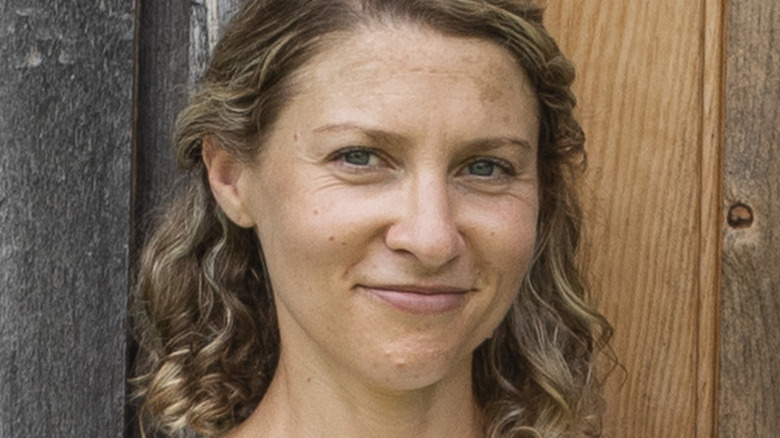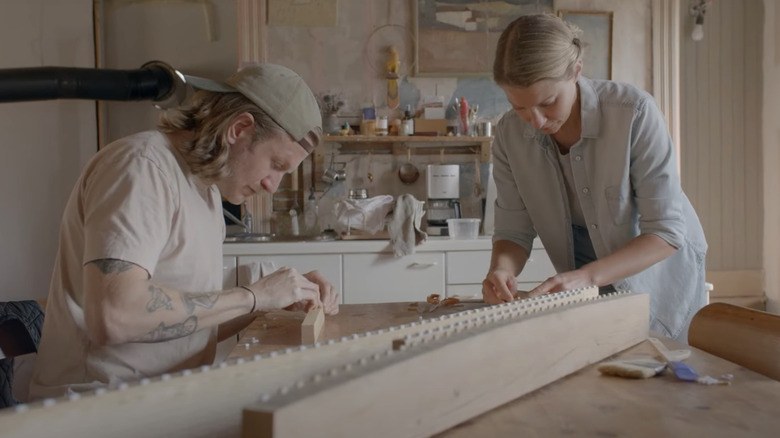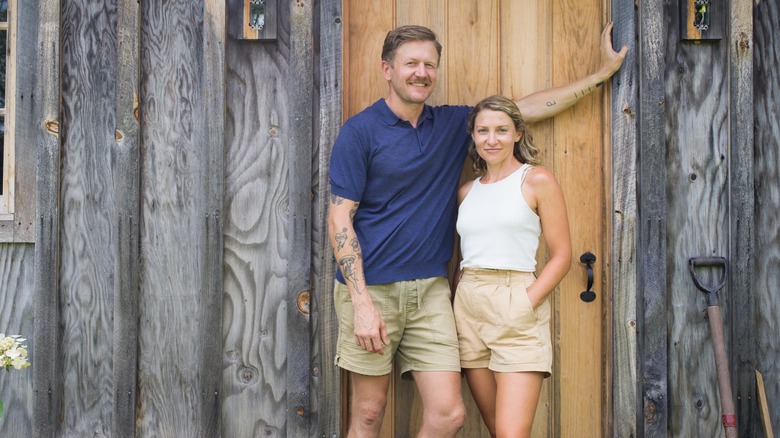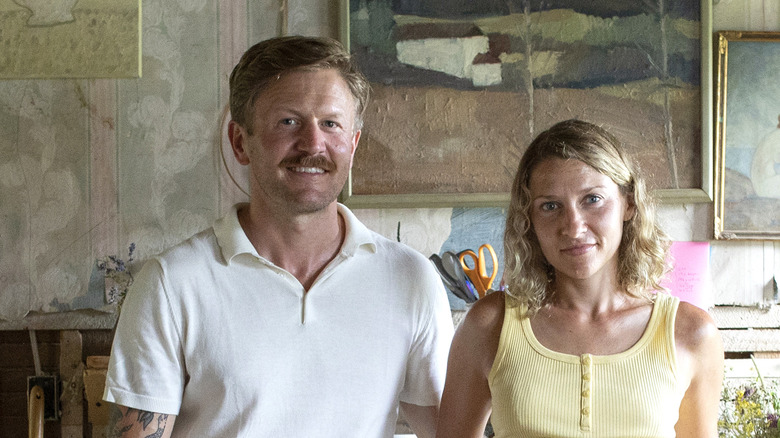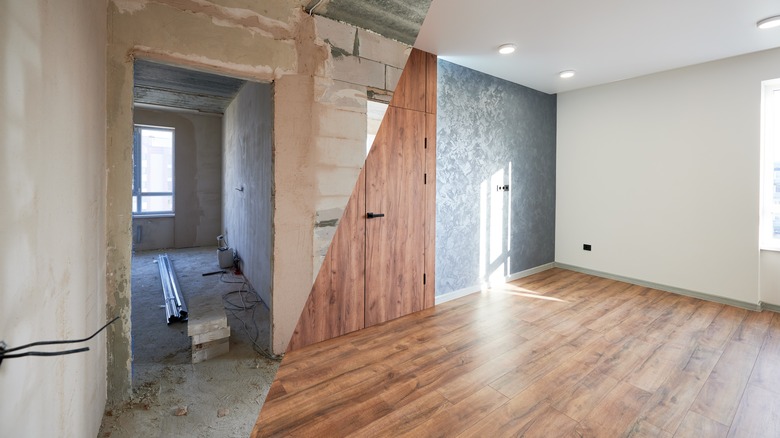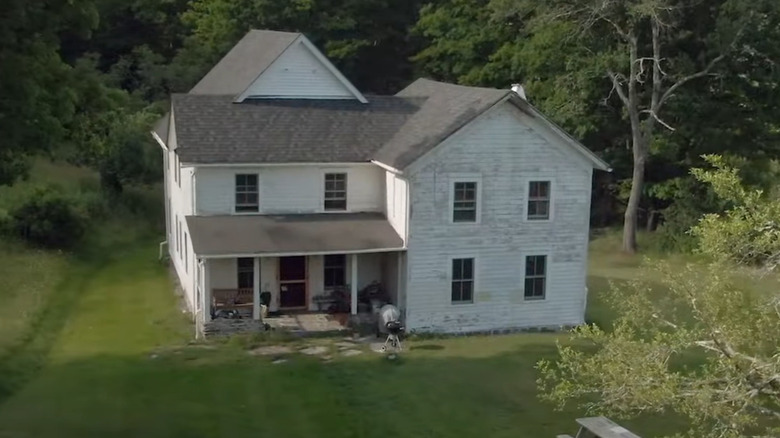The Story Of Home's Tara Mangini Talks Ongoing Renovation And Owner Advice - Exclusive Interview
As the founders of successful design company Jersey Ice Cream Co.,Tara Mangini and her boyfriend turned business partner Percy Bright have a hand in helping make homeowner dreams come true. While they don't sell ice cream, the nomadic designers do have a love for old houses and the freedom that comes with their unconventional design process of living in whatever house they are renovating.
Now, after recently buying an old house of their own in upstate New York, the couple finally has the chance to use their unique set of skills and design expertise to create a dream home of their very own, and their new show on Magnolia Network gives viewers an inside look. "The Story of Home" follows Mangini and Bright as they navigate the ins and outs of renovating their new home with the added complexity of simultaneously living in it – and highlights why work done by the Jersey Ice Cream Co. duo is so sought after.
In this exclusive interview with House Digest, Tara Mangini talks about her and Percy's new buzz worthy show and shares advice for homeowners who are in the renovation process — just like she is.
The early years of Jersey Ice Cream Co.
Congratulations on the upcoming show! I'm sure you guys are excited. Are there any moments in particular on the show that you're excited for viewers to see?
We've only seen the trailer, so we're so interested and curious to see what it is ourselves. It's one thing to be filming it and living it. I'm so curious what it feels like watching it — if I'm like, "That is what it was like," or if I'm like, "Who are these people?" In general, we did a lot of stuff in this house with tempera, which is this paint that you mix up from pigment with egg oil and water. It was something we learned on this trip to Sweden, and it was a huge inspiration for us for this. We painted trim with it, but we did these wall prints with it.
It was something that felt really beautiful in the moment, even though work doesn't always really feel like that. I'm excited to see if that feels as magical on camera as it did to us doing it.
How did you both get started in interior design?
We are both not trained in interior design. We met in Philly 12 years ago, and we had both been doing stuff in graphic design and advertising. There was some thread of something creative happening. When we met, Percy had recently bought a house, and shortly after that, got laid off from his job. He was like, "All right, I'll hire some people. They'll be working on this. I'll be at my work. I guess I'm going to do this house instead."
Free time, no money [is] the classic combo. I was waiting tables and was like, "What will I do with my life now?" We were both in an aimless spot but naturally, we're like, "I love going to flea markets. I'm into this. I love talking about paint colors." We started working on the house together. We started with a little Etsy shop. It was like, "We could sell vintage stuff. That'd be fun."
After doing that for a bit, we realized that didn't feel like enough control over the process. We're almost like, "It's so funny because we've actually been designing this house on the side this whole time, and maybe that's the thing we actually want to do. Let's try to see if Design Sponge will buy that we're designers and feature this house." They did, and then it was off to the races.
The design process explained
I know you guys have a little bit of an unconventional design process when you design for others. Can you walk us through what that looks like from start to finish when you take on a project for somebody else?
Basically, the whole thing was born out of necessity. When we got our first big project, it was in upstate New York. We had been living in Brooklyn, and we were broke. All those things — we had no money [and] a really low budget for the project. We're going to live in the house because what else would we do? We're not going to commute, we're not going to rent a place, and we can stay here for free, so, cool.
We didn't know anything, because we're not classically trained. We didn't know any better. If you know how the process works, I would've been more like, "This isn't how they do it," but we were like, "We'll live here and sleep on the floor, and we don't care." We were so excited to do something.
We lived in that space for that project. All of our work tended to be upstate in these remote places, and we were like, "Yeah, we'll move in and do it." That became such a part of our process, being in the space while renovating it, that that's how things evolved. When we went to do "real" projects with budgets and contractors and we weren't sleeping there, we were like, "I feel like we're losing something."
Right now, we're setting up the kitchen in this house. I spent the day trying to organize it, and then I went to make dinner and I was like, "Oh my God, this is so much new information. I need something, where to put the pot?" Doing that stuff, living in the space and using it, you so quickly are like, "I realize there's nowhere to put this thing," or that you always scuff this wall when you walk by.
Things that you end up incorporating into it have become a really big part of our process, as well as doing everything ourselves. It's hard to find work or we didn't have the budget for it, or we were in a hurry or whatever. It has become how it all goes down.
Tara talks the difference in working on her own house and shares advice for other creatives
How has your design process changed since buying your own home? Are there any major differences that you've encountered when designing your own home, versus doing work for somebody else?
The hope when we started was, "This would be so great. We can take our time." There would inevitably be a part in the project, the end, where we were like, "If we had one more month, we could get it to where we want, but we have to leave." We're like, "How great! We can take risks, we can take our time." We have done that, but we're also like, "This is taking forever." The freedom of time expands time. Budgeting, paying for the project yourself adds a new twist.
What advice would you give to somebody who, like you, is passionate about interior design but doesn't have formal training and isn't sure where to start?
We have this fortunate experience of having an actual house to work on that was low stakes. It wasn't for a client. It was for us. It's like when you're trying to write something, and you always write and people are like, "You're a good writer." You go to write something and you don't know how to do it. We were doing it so absentmindedly in the background, not trying to go right at it, that we were able to fall into it and loosely do it without this pressure and paralyzing, comparing to other things. We were so blind to all that it was able to unfold.
If you can create some low stakes but creatively free situations for yourself, to try without all of these stakes and pressures — the pressure kills you. The pressure kills creativity and comparing kills it. To find yourself in this free vacuum is ideal [but] really hard to do. It's something that we've been trying to get back to since our first project where no one's expecting anything. To know that everybody's still figuring it out — we are very much still figuring it out day to day. "What should we do? Does this look weird? Is this weird? Are we crazy? Is this cool?"
There's a constant push and pull, and trying and looking and seeing. It's definitely not like, "We've been doing it for 12 years, and now I walk into a room and I know exactly what to do." I talk to people and they're like, "I'm struggling." I'm like, "Who isn't?" People struggle. That's the process. It's a million decisions, second guessing, changing your mind, making mistakes. That's how it goes. If that's how it's going for you, that's okay.
In with the old
What advice would you give to somebody who is looking to buy and renovate an older home? Are there any major differences to be aware of when renovating something that's older, versus something that was built more recently?
When we bought this place, we had fixed up a bunch of old houses already. We're thinking, "We know the process." I'm sure I can't really capture it all in this answer, but there are things that are easy to fix up: walls that need to get painted, trim that needs to get painted, everyone's kitchen needs to get renovated, stuff like that. That's level, let's call it two.
There are other things that become so much more work, like insulating and foundation problems, and needing new windows, or to put heat in or move plumbing around. Those things make a project so much bigger. It's not necessarily just "old house, new house", but it's, "What kind of shape is this old house in?"
I don't think we realized how bad a shape this place was in, and we did all the things everyone does. "Skip the inspection, whatever, who cares? Let's do it." Even though we knew it had no heat and we knew it had no insulation, it was like, "Wow, this is major, major work. This is [more than] painting walls."
There's that to consider when you're buying it. It's hard to gauge, "How big is this project, really?" Everyone's project is probably bigger than they think it is, but sometimes, it's a lot bigger than you think it is.
Living in a house you're renovating is difficult but worth it
What advice would you give to somebody who is embarking on the chaotic journey of renovating a house while trying to live in it? Are there any tricks that you have found to help maintain your sanity while you're doing it?
I get used to it. There's definitely periods of, "This is absolutely unbearable. I'm losing my mind." You can't walk, everything's chaotic, there's nowhere for anything. Those usually lead to you being like, "We have to get a kitchen set up, something." Once you have that rough setup, it's really weird how used to it you can get.
We lived in a temporary kitchen with a bucket under the sink, and a hot plate and a convection oven for two years. "This is normal, this feels fine." You dump the bucket out the window, and you acclimate to it. That's the strange thing about it — you can get used to sleeping on the floor and doing that for a really long time. There's this suspended existence of, "This is temporary. This isn't our house, this isn't how we live. This is for now or something." There's all these [things you overlook] and grace periods that's like, "Isn't it charming?" That's the surprising thing is that you get used to it, or at least we do.
It's really hard to leave that space, clear the gook out of your eyes and go to someone else's house like, "Oh my God, this is so nice." Then, you see it again and you're like, "Wow, this is hard." It's going to be hard. It's going to take 25 times longer than you think. All that stuff. If we didn't like doing it, I cannot imagine doing it.
When we would do work for clients, I would always think it was so weird. They're walking in and they're like, "It's great," and I'm like, "You don't know how hard it was to get this thing in. The paint, and that in this corner, this thing happened." It's full of all these tales.
Are you working on any other projects right now, or are you keeping busy enough with the show and the house?
No, this is definitely it. We're trying to survive and finish the house.
"The Story of Home" premieres Tuesday, November 29 at 8 p.m. EST on Magnolia Network, streaming on discovery+ and the Magnolia app.
